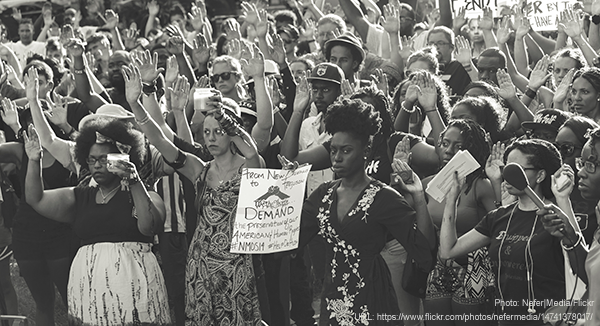365 Days and 605 Armored Military Vehicles Later: Police Militarization a Year After Ferguson


Last August, Ferguson and Fallujah had a lot in common. Those protesting the death of Michael Brown were met with “armored vehicles, noise-based crowd-control devices, shotguns, M4 rifles like those used by forces in Iraq and Afghanistan, rubber-coated pellets and tear gas.” The scene looked more like a foreign warzone than a Midwestern American town, and no one could tell why local police were taking up arms against those they are sworn to protect and serve.
The world was shocked by this highly and dangerously militarized response by local law enforcement. Foreign leaders equated Ferguson to combat zones in Iraq and Gaza. Veterans from the Iraq and Afghanistan wars expressed horror at the reality that they had been less heavily armed while on active duty abroad. President Obama reacted by saying “[t]here is a big difference between our military and our local law enforcement, and we don't want those lines blurred.”
Ferguson put a spotlight on police militarization, but the concern is not new. Just before the death of Michael Brown, the ACLU released "War Comes Home: The Excessive Militarization of American Policing." The report is a deep dive into police militarization, describing how some law enforcement practices have turned our police into soldiers and our neighborhoods into warzones. Special Weapons and Tactics (SWAT) teams are routinely engaged in militarized policing to carry out the so called “War on Drugs”.
The incidents reviewed in our report show that 79 percent of SWAT deployments were not emergency scenarios such as hostage or barricade situations, but rather home searches. More than 60 percent of those cases involved searches for drugs. And 61 percent of all the people impacted by SWAT raids in drug cases were people of color. Dr. Peter Kraska, professor of justice studies at the University of Eastern Kentucky, estimates that 80 percent of small towns have SWAT teams and 90 percent of larger cities have them. The number of SWAT raids per year has grown from 3,000 in the 1980s to 60,000 today.
"War Comes Home" calls out the federal government for providing military weapons and equipment to local police. The Department of Defense 1033 program, which sells military equipment at a bargain basement price to state and local agencies, is the epicenter of the controversy. And rightfully so. Since 2006, the 1033 program has provided local police departments with 11,959 bayonets, 205 grenade launchers, and 605 mine-resistant ambush-protected vehicles (MRAPs). In response, citizens are voicing their concerns. Over 77,000 people have supported the ACLU’s call to the federal government to stop funneling billions of dollars into the militarization of local law enforcement.
In response to all of this, President Obama issued Executive Order 13688 in January. The order created a federal interagency working group charged with investigating police militarization. As a result of the inquiry, the federal government is now banned from giving bayonets and grenade launchers to local police, but MRAPs are still in play. Granted, the working group has made it much more difficult to get an MRAP and a few other things. Now, police departments must establish community policing practices, training protocols, and have community approval in place before using federal resources to obtain some military equipment.
But what about holding police departments accountable for the 605 MRAPs already in circulation?
The Obama Administration should make the new requirements retroactive. If a police department wants to keep its MRAP, the local community should sign off. Additionally, anything that is now banned, like bayonets and grenade launchers, should be recalled. And Congress must pass legislation like the Stop Militarizing Law Enforcement Act so reforms are permanent.
It is critical that the federal government seek an end to our prohibitionist drug policies - the most glaring – and failed – policy resulting in police militarization. The War on Drugs has failed to stem the availability or use of drugs, has cost billions of dollars, has been a key driver of mass incarceration, and has disproportionately harmed communities of color. Beyond this, the Obama Administration must also take a look at the militarization of other branches of federal law enforcement. They should be alarmed by military-style raids by the Food and Drug Administration in search of raw milk or the Department of Education in response to financial aid fraud. And the ACLU has long been concerned about the militarization of border communities by Customs and Border Protection (CBP) – done in the name of immigration enforcement.
The Obama administration has made some progress on demilitarization, but in order to avoid another Ferguson, we must press on and ensure that our law enforcement maintains its pledge to serve and protect rather than occupy and terrorize.

